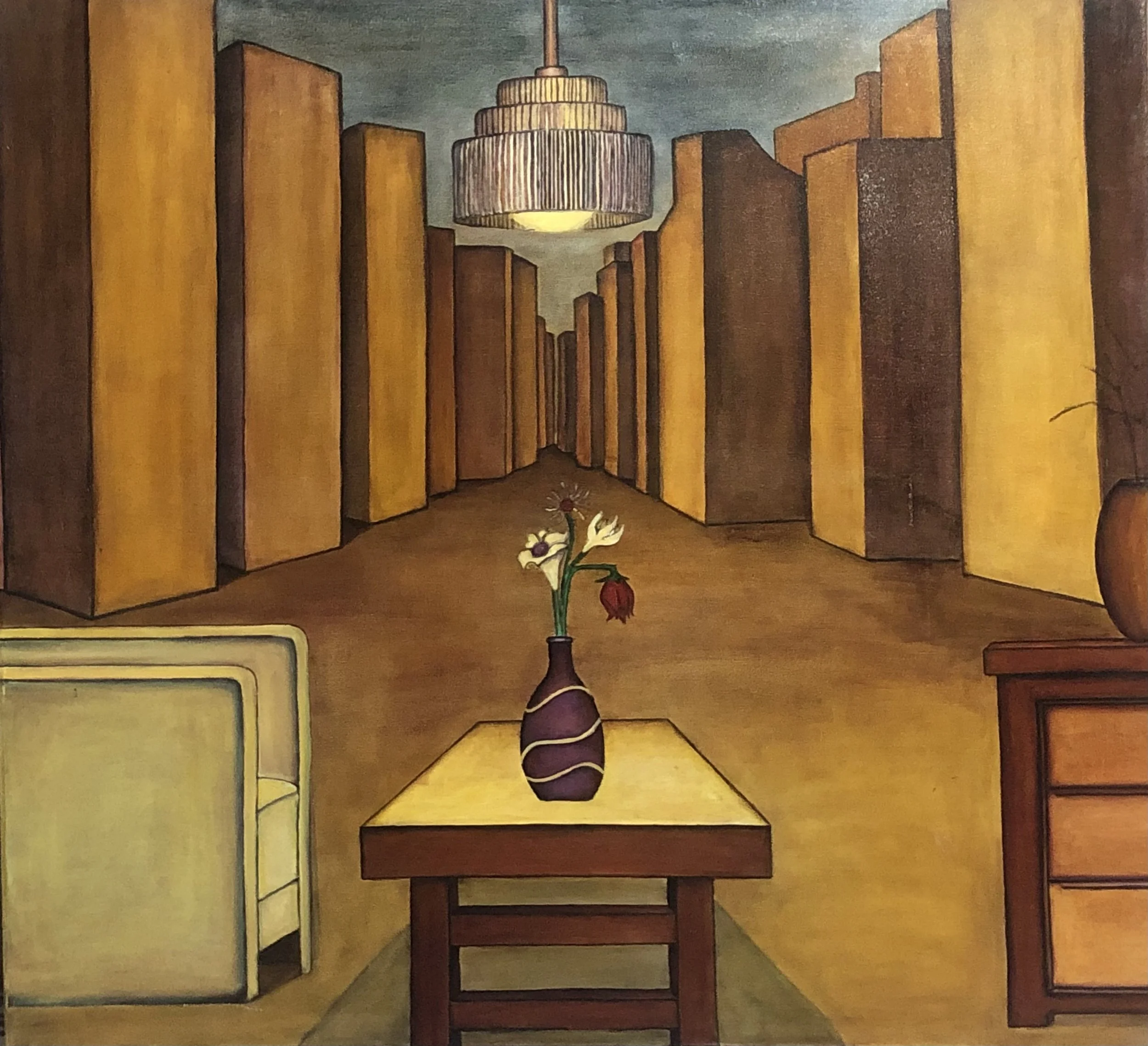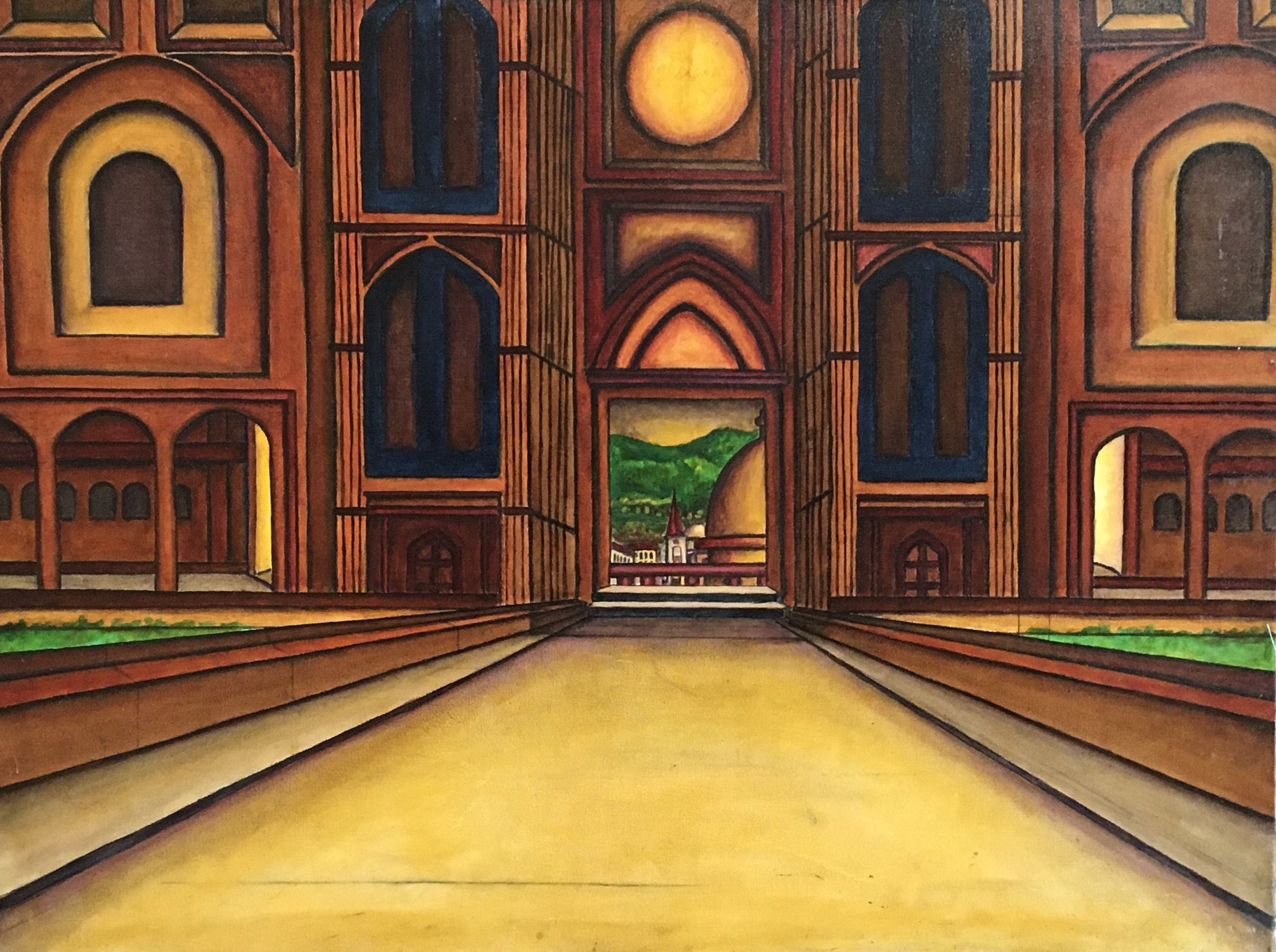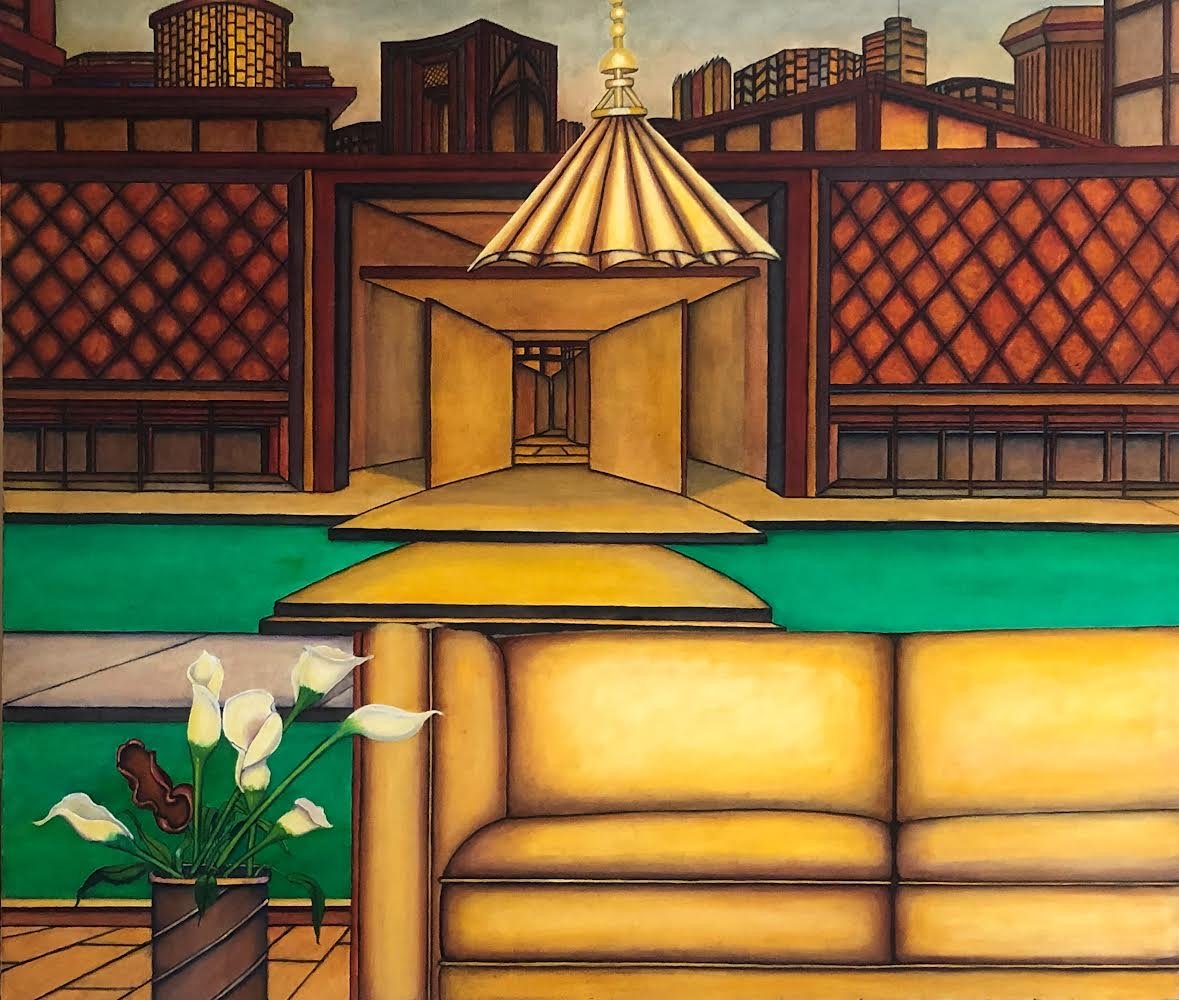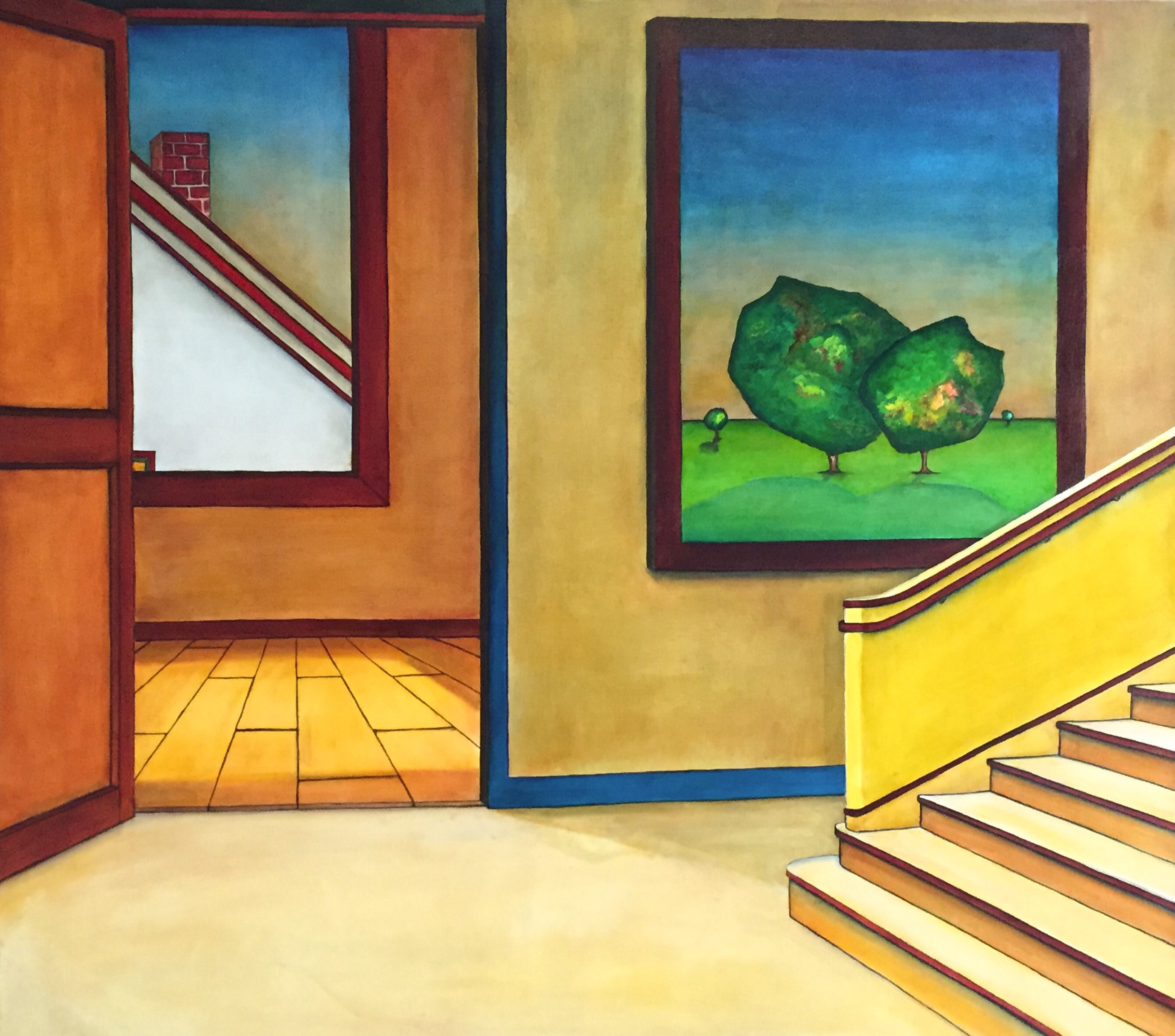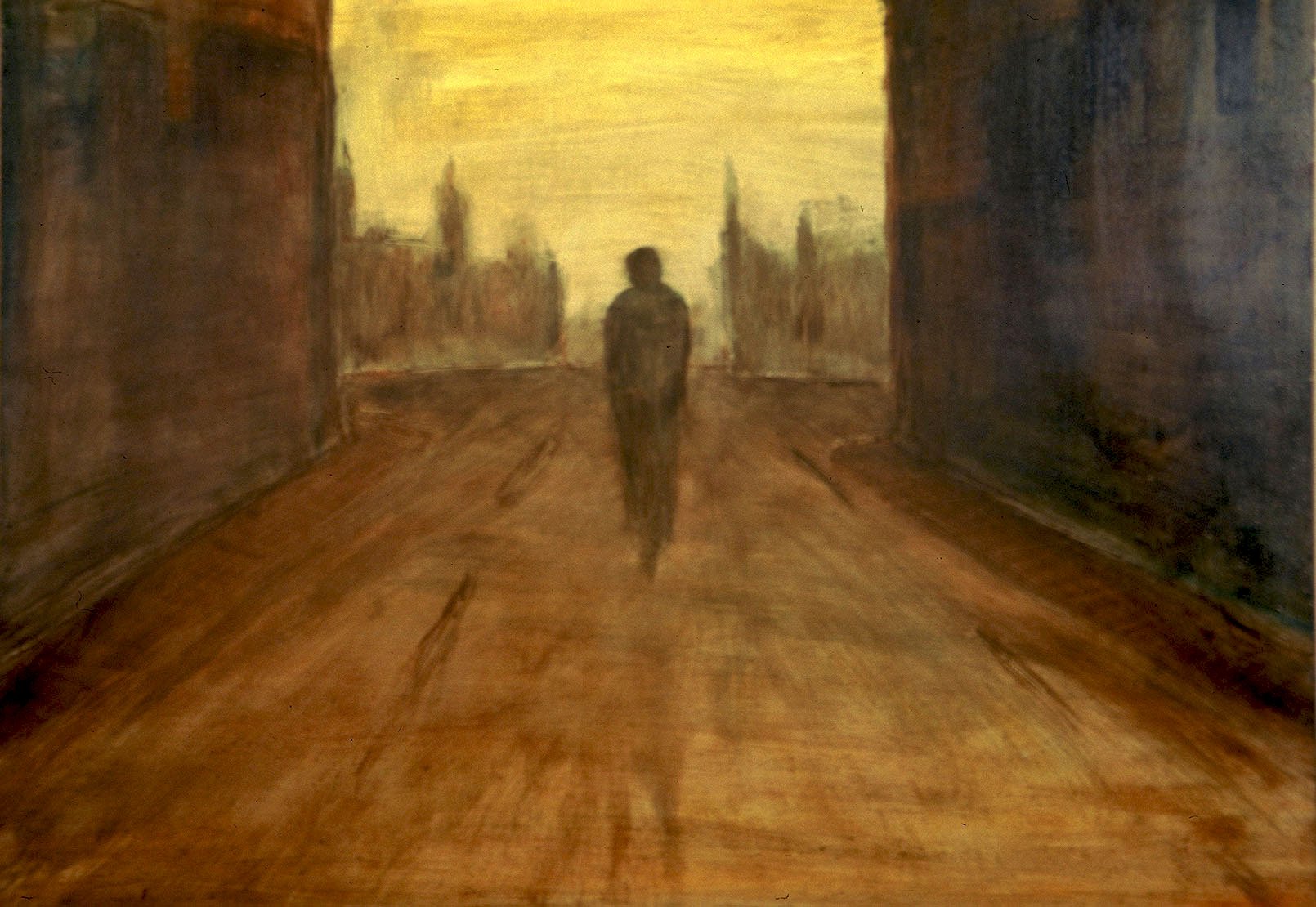Daniel McKinley
Daniel McKinley
Danielmckinleypaintings.com
Daniel McKinley's oeuvre presents a fascinating interplay of escape, time, and philosophy, painted in a style that masterfully melds the real with the surreal. His paintings are a pastiche of vivid hues and enigmatic spaces that invite viewers to step into an alternate reality where time is not linear and life's philosophy unfolds in layers of color and form.
Take, for instance, his portrayal of urban landscapes. McKinley doesn't merely paint cities; he reimagines them as labyrinths of memory and possibility. The urban scenes are often devoid of people, yet they pulse with the lives of those unseen. Skyscrapers become monolithic bookends to the human experience, while in other works, they are luminous beacons against twilight skies. Each building, street, and window seems to hold a story, suggesting a complex network of human experiences and the passage of time.
In works where the human figure does appear, it is often solitary, a shadowy silhouette against the city's grandeur. These figures seem to be on a journey, both literal and metaphysical, navigating through the architectural canyons that reflect the internal mazes of their minds. McKinley's use of perspective draws the viewer's eye into the vanishing point, a metaphor for the pursuit of meaning and purpose in life.
The juxtaposition of interior and exterior spaces in McKinley's paintings blurs the boundaries between the self and the surrounding world. Tables are set against cityscapes, and windows open to reveal other worlds, suggesting a fluidity of space and time. These thresholds invite contemplation of the dualities of existence—inside and outside, past and future, reality and imagination. They echo the human yearning for escape, not just from the physical confines of the world, but from the constraints of time itself.
Perhaps the most compelling aspect of McKinley's art is the way it captures moments that feel both transient and eternal. The stillness in his scenes is deceptive; it belies a deeper movement, a sense of life's impermanence and the ongoing flow of time. His paintings are like visual poems that speak to the core of our being, to our constant quest for understanding and connection.
McKinley's palette, rich and earthy, further emphasizes the theme of time travel. The warm ambers, deep reds, and subtle golds seem to hold the light of different times of day and different eras in history. The paintings themselves become time machines, where viewers can travel from the golden hour of a renaissance sunset to the crisp dawn of a modern metropolis.
The philosophical undercurrents in McKinley's work are profound. His canvases are more than mere art; they are contemplations on existence. The recurring motifs of doors, windows, and pathways are invitations to explore the unknown and to consider the paths we choose in life. His representation of light, whether it's the glow of a lamp or the luminosity of a sunset, speaks to enlightenment—the illumination of the mind and soul.
In a world that often feels fragmented and chaotic, McKinley's paintings offer a sanctuary of thought and introspection. They are places where the weary traveler of life can pause and reflect, finding solace in the beauty of a world reimagined. Through his art, McKinley suggests that escape is not about fleeing from reality, but about finding depth and meaning within it.
McKinley's paintings are thus not just beautiful escapes but are deeply imbued with a sense of the philosophical journey of life. They prompt us to question, to seek, and to wonder. Each painting is a unique narrative, a single frame in the grand movie of existence. They remind us that while we all travel through time at the same relentless pace, the journey itself is subject to our own interpretation and our willingness to explore the layers beneath the surface.
Daniel McKinley's art is a testament to the human spirit's resilience and its eternal quest for understanding. His paintings are a profound commentary on life's escapism, the relentless passage of time, and the philosophical musings that accompany our existence. They are not merely paintings but portals to introspection and discovery, offering viewers a chance to pause and reflect on the grand tapestry of life.
Daniel McKinley's art stands as a unique beacon in the contemporary art scene for several reasons, some of which stem from his distinctive approach to theme, technique, and narrative.
McKinley's exploration of escape, time, and life's philosophy diverges from the prevalent trends in contemporary art, which often focus on the immediate and the material. His works serve as a bridge to the metaphysical, encouraging a form of introspection that is becoming increasingly rare in an age dominated by rapid consumption and instant gratification. The layers of meaning in his paintings demand a slower, more thoughtful engagement from the viewer, which contrasts with the sometimes ephemeral nature of modern artistic experiences. In an era where abstraction, minimalism, and conceptual art have a significant presence, McKinley's representational yet surreal approach offers a fresh perspective. His ability to weave the real with the surreal, to blend architectural precision with dreamlike atmospheres, creates a visual language that is both accessible and deeply enigmatic. This dichotomy captivates audiences and sets his work apart from both the starkness of pure abstraction and the rawness of hyper-realism that often characterize contemporary art. McKinley's meticulous attention to detail and craftsmanship is a homage to traditional painting techniques, yet his application is thoroughly modern. He balances this classical foundation with a contemporary sensibility, creating works that are timeless in their appeal. His technique, which often involves layering and a rich color palette, results in a tactile quality that invites viewers to look closer, to appreciate the skill and labor evident in every brushstroke. While many contemporary artists are moving away from narrative, McKinley embraces it. His paintings tell stories, but not in the literal sense. They suggest narratives, leaving gaps for the viewer to fill, which creates a participatory experience. This engagement with the viewer is not just visual but intellectual, and in a fragmented media landscape, such an invitation to weave personal stories into the canvas is distinctive. The philosophical bent of McKinley's work offers a counterpoint to the sometimes overtly political or social commentary found in contemporary art. His canvases ponder universal themes and existential questions that transcend the current moment, providing a space for reflection on the constants of human experience—time, memory, existence—rather than the fluctuating currents of the zeitgeist. At a time when reality can be overwhelming, McKinley's art provides a haven for the imagination. His work is an open door to worlds that flirt with the fantastical, offering an escape that is both a relief and a profound commentary on the nature of reality itself. In the contemporary art scene, where realism and grit can often dominate, his lyrical and otherworldly landscapes provide a necessary balance. McKinley’s handling of temporal elements is particularly distinctive. His art doesn’t just represent moments; it seems to encapsulate epochs, inviting a form of time travel. This resonates deeply in an age where the digital has collapsed distances but also compressed our experience of time.
In essence, McKinley’s art is unique because it manages to be both an anachronism and highly relevant. It harks back to the grand themes of art history while engaging with the contemporary audience on a level that is both deeply personal and universally resonant. His work doesn’t just occupy physical space in galleries; it occupies mental space in the minds of its viewers, prompting a dialogue that continues well beyond the initial viewing. This enduring impact is a hallmark of true uniqueness in the contemporary art world.
Daniel McKinley's placement within the contemporary art scene is quite distinctive. He occupies a niche that bridges the gap between traditional painting techniques and the philosophical narratives of contemporary life. This sectioning within the art world can be viewed through various lenses. McKinley's work, with its strong base in traditional painting skills and craftsmanship, positions him as a contemporary traditionalist. He honors the classical form while infusing it with modern themes and perspectives, making his work appealing to both conservative art lovers and those seeking innovation within familiar frameworks. In a scene dominated by conceptual and abstract art, McKinley’s representational yet surreal paintings provide a counterbalance. While much of contemporary art moves towards the non-figurative and the experimental, McKinley holds onto the figurative narrative, giving him a unique voice that stands out for its clarity and depth. McKinley could also be placed as a philosophical storyteller in the contemporary art scene. At a time when art is often a platform for social and political commentary, his work provides a meditative pause, asking timeless questions and exploring the human condition in a way that is less common in the current climate.
He might also be seen as part of a surrealist revival, using techniques reminiscent of the early 20th-century movement to create dream-like scenes that challenge perceptions of reality. However, unlike historical surrealism, which often delved into the subconscious mind, McKinley’s work seems to explore the conscious reflections on time and existence. In an age where digital art and NFTs are emerging trends, McKinley’s art offers an escapist antidote to the hyper-connected, technology-saturated culture. His work does not compete with the rapid turnover of digital media but instead provides a sanctuary from it, which makes his placement in the contemporary art scene both necessary and refreshing.
McKinley might also be considered an artist's artist—someone who resonates deeply with practitioners who appreciate the technical skill and thematic depth. His work is a reminder of the foundational aspects of art that transcend trends, which may not always align with mainstream commercial interests but hold a special place among connoisseurs and creators. Given the timeless appeal and the technical prowess of his work, McKinley is likely to be favored in the traditional gallery circuit and by private collectors who are looking for works that stand the test of time both in technique and thematic relevance.
Artists like McKinley often have a strong influence on the educational aspect of art, providing a touchstone for students and educators who wish to connect historical techniques with contemporary themes. This educational placement is important as it influences emerging artists and the direction of art education. McKinley’s work can be seen as a form of cultural commentary, one that might not be as direct as other forms of contemporary art, but which nonetheless offers a rich tapestry for discussion about where society stands in relation to its past, present, and future.
McKinley’s placement is that of an outlier who touches the core of the human experience, an artist who maintains the essence of traditional art while engaging deeply with the questions and longings of the contemporary individual. His work stands as a fulcrum between the fast-paced changes of the contemporary world and the timeless pursuit of artistic expression.
By Marta Puig
Contemporary Art Curator Magazine Editor

